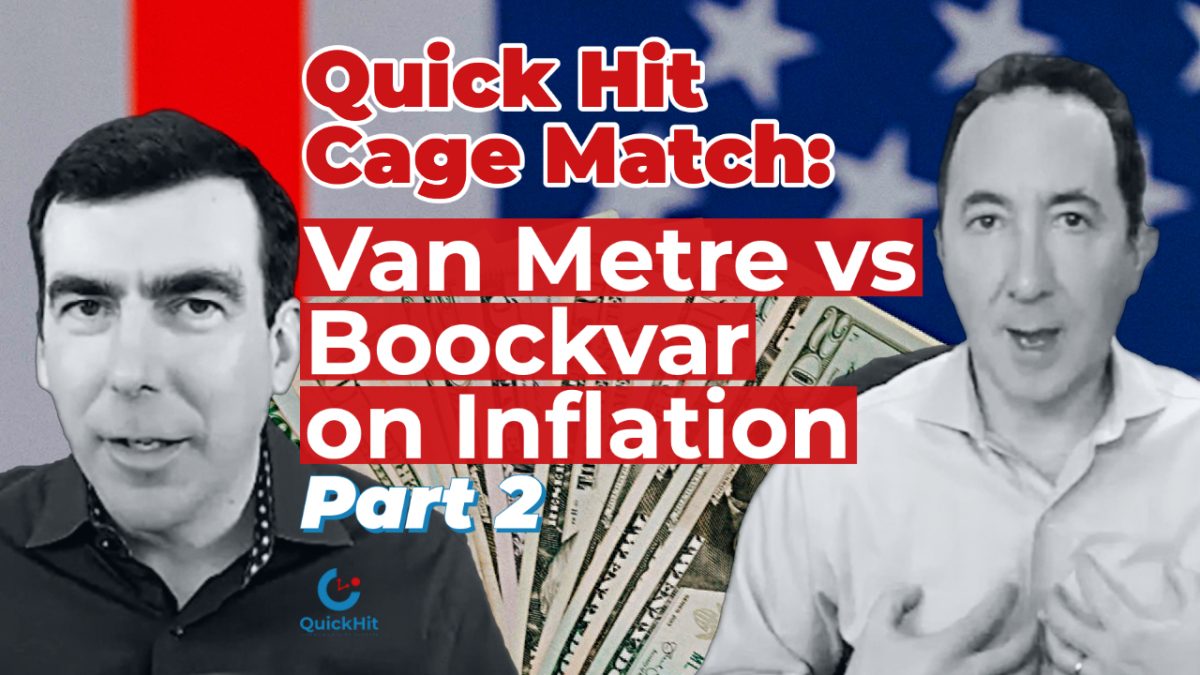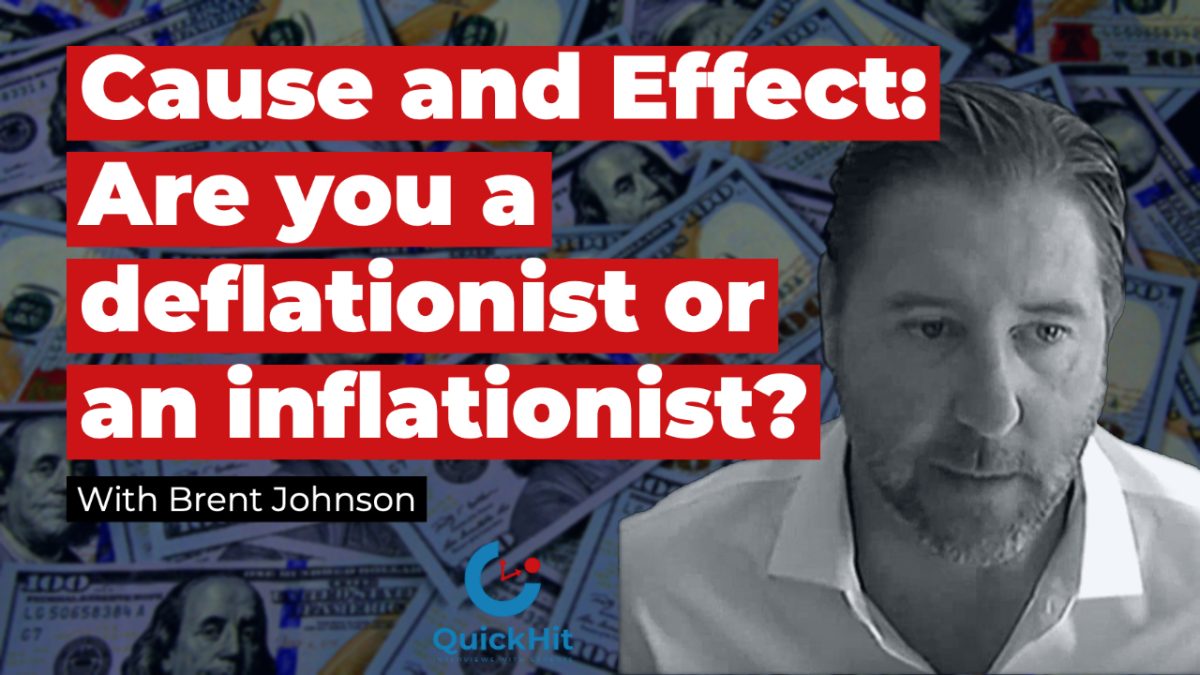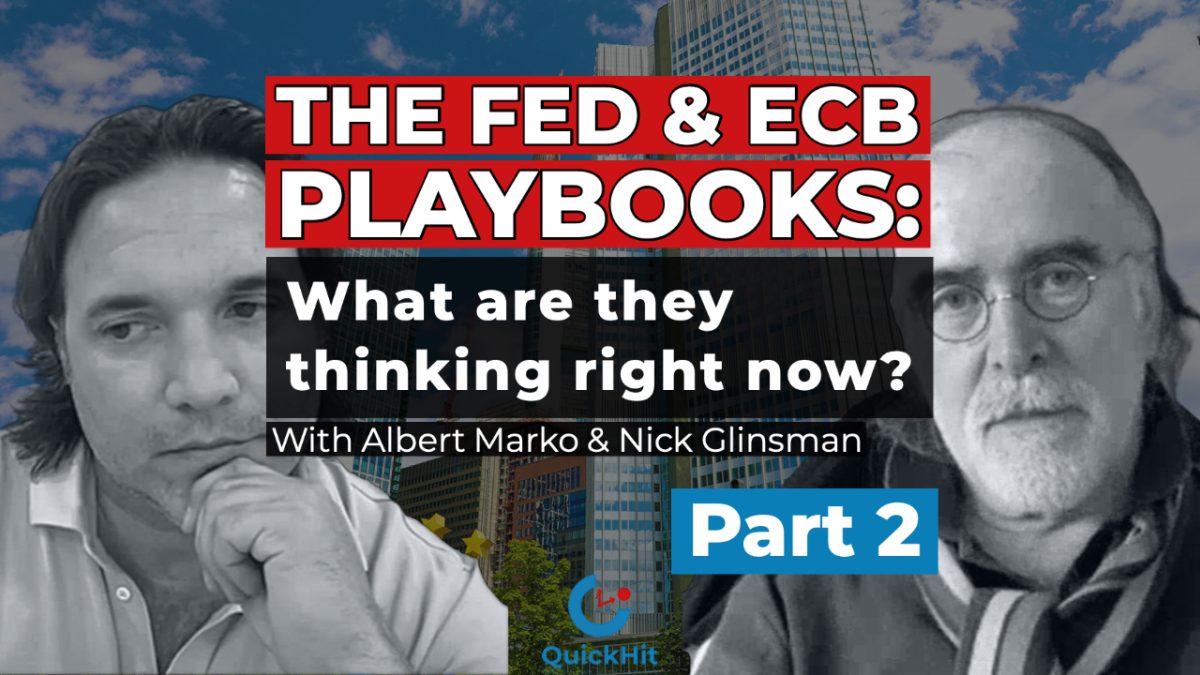This is Part 2 of the inflation discussion with Steven van Metre and Peter Boockvar with your host Tracy Shuchart. In this second part, they talked about the possibility of the Fed tapering this year or early in 2022. How about the possible rate hike and what will possibly happen in other parts of the world like Bank of Japan and Bank of England if ever this happens? What is Powell doing exactly and why? Is there a possibility of a new Fed chair next year? And what do they think about stagflation?
For Part 1 of this QuickHit Cage Match episode, please go here.
Steven van Metre is a money manager who have invented a strategy called Portfolio Shield. He also has a YouTube show that discusses economic data and the news three days a week.
Peter Boockvar is the Chief Investment Officer and portfolio manager at Bleakley Advisory Group. He has a daily macromarket economic newsletter called The Boock Report.
💌 Subscribe to CI Newsletter and gain AI-driven intelligence.
📊 Forward-looking companies become more profitable with Complete Intelligence. The only fully automated and globally integrated AI platform for smarter cost and revenue planning. Book a demo here.
📈 Check out the CI Futures platform to forecast currencies, commodities, and equity indices
This QuickHit episode was recorded on October 14, 2021.
The views and opinions expressed in this Quick Hit Cage Match: Van Metre vs Boockvar on Inflation Part 2 episode are those of the guest and do not necessarily reflect the official policy or position of Complete Intelligence. Any contents provided by our guest are of their opinion and are not intended to malign any political party, religion, ethnic group, club, organization, company, individual or anyone or anything.
Show Notes
TS: Do you see the Fed tapering? And if they do, how much is this going to affect inflation? And also, I know the market is saying the Fed is going to raise rates in ’22, 2023. But is this a reality at all?
But before we jump into that, I just wanted to remind you to please subscribe to our YouTube channel.
PB: I think the Fed will at least start the taper and see how it goes. The thing that is different with this taper is that it’s coinciding with central banks around the world that are also beginning to remove accommodation. However slow, however glacial that process is, they’re all outside of the BOJ. They’re all doing it at once.
So if the Fed starts to taper in December, which they basically told you that they will, well, the Bank of England could be raising rates in December. We recently got a rate hike from Norway a month or two ago from South Korea. We’ve had Canada and Australia trimmed QE. Even the ECB has trimmed QE. So there’s a global shift to tightening. And I do believe tapering is tightening to define that. Just as we saw last year, the past 18 months obviously massive global easing.
Now I can’t even discuss the rate hike situation because I’m not even sure that they’re going to be able to get through the tapering. If you look back to 2010, every single notable market correction in equities and also fixed income markets outside of Covid and the one evaluation in August 2015 coincided with the end of QE, where it was a hard stop QE1 and QE2. And then obviously you had the taper 2013 and then obviously around rate hikes. Every single one coincided with a tightening of policy. And even again, it was gradual. It still affected markets. And we’re going to have it again to think that we’re going to somehow get through tapering without any accidents, I think, is delusional. And you believe that there’s a free lunch and it’s a matter of what kind of accident occurs by this.
Now QE itself essentially, at the end of the day, it’s an asset swap. And yeah, does some of that money sort of filter into markets? Yeah, maybe, I guess. But a lot of it’s psychological, but it also does help to, at least on the short end, suppress interest rates to where they would be otherwise. That said, when QE has been on, you’ve been paid to steepen the curve when QE is off, it pays to flatten it. And I think we’ve seen some recent flattening in the yield curve. And I think that that has been the right trade to do when QE is about to turn off.
But to Steve’s point about the bottom 50%. Well, if you get a short equity market correction, well, the top 50% is going to feel that as well. And yeah, can that filter into how they spend for sure? But that doesn’t necessarily resolve the supply issues.
That’s how this inflation story is going to recalibrate. The supply side is going to take a couple of years, and it’s going to be less demand. That is going to recalibrate this inflation story. And I think that is. No central bank wants to preside over a declining economy. But unfortunately, you’re going to have to have a trade off. You want lower inflation and a slower economy or an economy, as is but fast inflation, that’s going to hurt the people that can least afford it.
SVM: Yeah, this balance sheet taper thing is really interesting because I will be on record. I’ll hold on record still, and I don’t think the Fed’s going to do it. Although, as Peter mentioned, you just said that you think that the Fed is going to start and then quit. I’ve had to come to your side of the fence on that deal, mainly because when Powell spoke at Jackson Hole, it seemed like he was saying, we can’t make this mistake. We got to keep easing because we could let off the gas too soon.
And then for whatever reason, there’s this massive pivot between that and the last meeting. And he’s going to have a disadvantage going into the November F-O-M-C. And not have the non farm payroll report because he concludes me on Wednesday. Nonfarm payroll is out on Friday. Maybe he’s got some early access, who knows? But it seems like all of a sudden he’s in a panic to start tapering.
Now, could this be because we know the treasury is going to reduce their issuance of notes and bonds as we borrow less money, and he doesn’t want to be over purchasing? Sure. Could it be, as Peter mentioned, that the other central banks are tapering and starting to raise hike rates. And that’s interesting, because the way I look at it is that would be a catalyst if the Fed doesn’t start tapering, that the dollar goes higher.
Well, there’s part of the inflation story that almost nobody is looking at. What if the dollar gets up into 96, 97, maybe even close to 100? I mean, we’re talking about destroying the inflation story just from the dollar alone. And is this one of those things where we had coordinated easing? So now we need to have coordinated tapering to keep the dollar from going up too much? I’m not sure what his motivation is, but I will say this. There’s no way that they get to the end of that taper. There’s a 0% chance they’re going to raise rates. And even if they did, it doesn’t matter. They’ve effectively given the banks a pass by saying, look, there’s no reserve requirement because, well, you’ve got all these QE reserves you don’t need anymore.
The whole idea that we’re going to get this balance sheet unwound. I think the bond market is telling us the Fed’s making a mistake. I think, Peter, you and I agree that we don’t know how many months they’re going to go? The only question is, at what point is there a payroll report or some data that comes out that the Fed goes, “Oh, my God, we made a big mistake.”
PB: I’ll tell you why he’s doing this. Well, first of all, the whole purpose of monetary policy, as we know, is to push the demand side. And if you look at what are the two most interest rate sensitive parts of the economy — it’s housing and autos. So is Powell with a straight face going to say, I need to pedal to the metal, continue to stimulate the demand for housing and autos, when you can’t find an auto and the price of the home is worth 20% more than last year? They need to take their foot off that demand pedal. And he does not want to be Arthur Burns. He does not want to be Arthur Burns. And right now he is headed towards being Arthur Burns.
And the Fed is going to reach a pivot point, where if inflation still remains sticky and persistent, but growth is really decelerating to a greater extent than it already is. And we know that the Atlanta Fed third quarter GDP number has one handle on it. He’s going to have to reach a point, do I try to come inflation, but then risk further weakness in the economy and a fall in asset prices, which JPowell obviously inflated. Where is he going to just not really respond quick enough. And being in Washington, we can be sure he probably leans towards trying to save the economy, but then that creates its own problems.
The one thing in the dollar, the dollar is going to get tied into this, too, because if he remains too easy for too long, well, that may sacrifice the dollar. If he is more aggressive at dealing with inflation, well, then you can see a faster move in the dollar. So he’s just been an absolutely no win situation here. But there is going to be a pivot point where he’s going to reach that we’ll have to see, does he go down the Paul Volcker route, or is he going to go continue down the Arthur Burns route?
SVM: See, Peter, you just said it best. He didn’t know what his situation. And all we’re debating is, at what point does he back off and quit because he realizes it’s not working? I mean, we can look at the velocity of money and see the monetary policy is not functioning properly.
I mean, there was a lot of people that predicted at the end of the last quarter that as economy reopen, velocity would pop. But it didn’t because of the fact that monetary policy is not transmitting into the economy. And so now the real issue is if he starts tapering and it does do what it’s supposed to do, does he inadvertently tighten financial conditions? I mean, this is such a mess of what he’s got to deal with. And I don’t know if you’ll agree with me honest, but I don’t think they have a clue what they’re doing.
I think they’re just betting that this is all going to work out, that Powell, as himself, is going to get renominated. And somehow, in the end, either he’s going to look like a superhero and say, look, see, I did it and go out as one of the most celebrated Fed chairs ever. Or he’s going to find someone else to blame this on when it doesn’t work.
PB: The Fed has been winging it for decades, and this all goes back to Greenspan. In 1994, he raised rates aggressively. We know he blew up Mexico, he blew up Orange County, California, and he took that at heart. He learned a lesson. And so you go into the late 90s when everything is on fire. Stock market bubble. We know he was very slow to raise interest rates because he didn’t want to repeat 1994.
And then, of course, you have the blow up. And he’s obviously quick to raise interest rates. But remember the mid 2000s, every single. When he started raising interest rates, he did it every single meeting, and in every single statement, it said, we are doing this at a measure pace, because he didn’t want to repeat 1994.
And then what we have, obviously, the housing bubble and so on and so on. And then now you take Powell. We know Janet Yellen was afraid to raise interest rates. Took them seven years to get off zero. And then after finally raising, took them another twelve months to finally raise rates again. And then Powell started to pick up the pace. And then he blew himself up in the fourth quarter of 2018. And then that helps to explain why they’re going so slow now.
Then you throw in, of course, the whole social justice. The Feds become the Ministry of Social Justice now and how they view monetary policy. But yeah, to your point, they are winging it. And they’ve been winging it for decades.
SVM: And you bring up an interesting point about 2018. I’m really glad you did, because a lot of people forgot that we started easy to the point that it didn’t really make a lot of sense from the outside look in it. And so now this whole notion, and I don’t know what your reaction was, but I remember hearing the press conference when he’s like, okay, when Powell said, “We’re going to gradually unwind the balance sheet by mid 2022.” I’m like, since when is “gradual” six months. There’s no way this is going to work for you, buddy, but good luck if you’re going to pull it off.
PB: Yeah. And the Fed got lucky for a period of time. They got lucky in 2017 because the markets rallied and ignored Fed rate hikes and the beginning of the shrinking of their balance sheet. They were double tightening and they got bailed out because everyone focused on the corporate income tax cut. That obviously happened at the end of 2017. But that entire year, the Vix got down to eight. Every dip was bought because everyone was pricing in that tax cut. But once that tax cut was in place, the Fed then raised interest rates again in January 2018. And then we immediately shift back to the Fed is double tightening here between the balance sheet and rates. And that obviously coincided with the fourth quarter of 2018.
So we know in the Fed tapering, the Fed tightens until they hit a wall. The Fed tightens until something breaks, and you can be sure something will break in 2022. It’s just a matter of how deep they get. And also one last point here is that having low inflation gives central banks that Wayne’s World Concert pass that all access to do anything they want for how long as they want, when there’s no inflation. But once you get inflation into the numbers, into the economy, their flexibility is greatly diminished. And that will be an interesting sort of tug of war as they get further into the tapering and something eventually breaks.
TS: One last question, a couple of last question. How do you feel about Stagflation? I kind of amend the Stagflation camp. Do you think that’s a cop out or how do you feel about that?
SVM: I think it’s temporary. I mean, we’re supposed to be rising unemployment. I mean, I guess with people coming off the ranks, I don’t know. Maybe it’ll go back up. I don’t think that’s likely to happen. And then you tend to get that with higher prices. But when we start looking at the bond market. The bond market is starting to tell us that, hey, this Stagflation is going to be transitory. And then the risk that I see is that we get into outright deflation from here.
PB: To me, I just look at stagflation as just slower growth and higher inflation. And in an economist textbook, they think that slow growth means lower prices. Faster growth means higher prices. I’m just looking at the Bank of Japan. The Bank of Japan said we need to get inflation at 2%, and somehow that will then generate faster growth. To me, they’ve got that backwards. You need stable prices in order to develop and sustain healthier growth.
So right now. But the Stagflation it’s sort of intertwined in the sense that it’s the inflation and what is driving it. So it’s the inflation itself that is beginning to impact consumer spending. And it’s the factors that are creating the inflation, like the supply bottlenecks that in itself, are also creating slower growth.
TS: Excellent. One last question, just for a thought experiment. I mean, say Powell does leave the Fed next year and we have find a Dove, right. So what does the Fed look like at that point if we have a dove as a Fed chair?
PB: Well, 2022 becomes completely politicized. The Fed’s already politicized, but it becomes Uber politicized in 2022 because of the elections in November. And if a Lael Brainard becomes the next Fed chair in February, 2022, you can be sure that Steve and I are right, that there’s no chance in hell they’re going to finish this taper because the second something breaks, you know, they’re going to back off and they’re going to do their best to, or at least the Democrats headed by the Lael Branard will do their best to maintain control of Congress.
SVM: Yeah. I’ll put that as a low probability chance that Powell is out. If he does, I’m 100% agree.
PB: I agree. I think he stays as well.
SVM: Yeah, 100% agree. I think it’s a big risk for the Biden administration to pull him. He hasn’t really done anything wrong. But if he does, again, I think Peter is spot on. I mean, now it becomes even more political than the Fed is supposed to be. And he’s right, as soon as something goes wrong, I mean, we’re going to 120 billion a month. Yeah, right. It’ll be multiples of that in a second.
TS: All right. Well, I want to thank you both again for everything you shared with us today. Can you each tell us where we can find you on social media or otherwise?
PB: Well, I just want to say thank you to Tracy and Steve. Thank you for having me in this debate and discuss this with you. It was definitely a fun time. If you want to read my daily readings, you can subscribe to boockreport.com. boockreport.com And our wealth management business is at bleakley.com.
TS: Excellent.
SVM: I want to thank you as well. Peter, you and I know this has been a long time coming for us to be on the same screen together. I had a blast. Totally looking forward to the next time. If you want to find more about me, you could go to my website. stevenvanmetre.com On Twitter @MetreSteven. On YouTube at @stevenvanmetrefinancial.
TS: Great. And for everyone watching, please don’t forget to subscribe to our YouTube channel and we look forward to seeing you on the next QuickHit.









